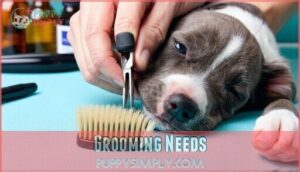This site is supported by our readers. We may earn a commission, at no cost to you, if you purchase through links.

They sport muscular builds with broad chests, short smooth coats in colors like brindle and black, and intelligent brown or blue eyes. Watch for hip dysplasia and skin allergies.
You’ll need to provide 1-2 hours of daily exercise and consistent positive training to manage their terrier energy and protective instincts. What many owners don’t realize about training these determined little athletes could save you months of frustration.
Table Of Contents
- Key Takeaways
- What is a Pocket Pitbull?
- Pocket Pitbull Appearance and Size
- Are Pocket Pitbulls Rare?
- Pocket Pitbull Temperament and Personality
- Pocket Pitbulls With Children and Other Pets
- Are Pocket Pitbulls Good Family Dogs?
- Health Issues in Pocket Pitbulls
- Caring for Your Pocket Pitbull
- Training and Socializing Pocket Pitbulls
- Pocket Pitbull Puppies: Price and Adoption
- Frequently Asked Questions (FAQs)
- What is the average cost of a pocket pitbull puppy?
- How big is the litter size for pocket pitbulls?
- What types of foods and treats are ideal for pocket pitbulls?
- How much do pocket pitbulls shed daily?
- What vaccines do pocket pitbulls specifically need?
- Can pocket pitbulls live in small apartments?
- Do pocket pitbulls bark excessively at night?
- What age should pocket pitbulls be spayed?
- Conclusion
Key Takeaways
- You’ll get a loyal, compact companion that weighs 11-22 pounds and stands 12-16 inches tall – perfect for apartment living while retaining the pitbull temperament and protective instincts.
- You’ll need to commit to 1-2 hours of daily exercise and consistent positive reinforcement training since these energetic dogs inherit both pitbull determination and terrier stubbornness.
- You should expect to pay $1,500-$2,500 from reputable breeders, plus ongoing costs for potential health issues like hip dysplasia, skin allergies, and heart problems common in this crossbreed.
- You must prioritize early socialization and training to manage their protective nature around strangers while ensuring they remain gentle family companions, especially with children and other pets.
What is a Pocket Pitbull?
You’re looking at a crossbreed that combines the American Pit Bull Terrier with the Patterdale Terrier to create a compact companion.
This designer dog gives you all the loyalty and spirit of a pitbull in a smaller 12-16 inch frame that weighs just 11-22 pounds.
Origin and History
The Pocket Pitbull emerged in the 1990s through deliberate breed development by early breeders crossing American Pit Bull Terriers with Patterdale Terriers. This historical purpose aimed to create a miniature pitbull retaining the original’s loyalty and strength while fitting compact living spaces.
Key historical milestones include:
- 1990s Breed Development – Systematic crossing began for size reduction
- Terrier Influence – Patterdale genetics added hunting instincts and tenacity
- Designer Dog Classification – Gained popularity as hybrid companion breed
- Breed Recognition – American Bully Kennel Club acknowledges Pocket Pit Bull standards. These dogs are known for their compact and muscular build.
Parent Breeds
What breeds create this compact powerhouse? The Pocket Pit Bull combines the American Pit Bull Terrier with the Patterdale Terrier.
This crossbreeding brings together Pitbull Traits like loyalty and strength with Patterdale Influence including hunting instincts.
Temperament Inheritance varies, affecting Size Variation and Breed Health. Understanding these Parent Breeds helps you predict your dog’s characteristics and needs.
Pocket Pitbull Appearance and Size
You’ll recognize a Pocket Pitbull by their compact, muscular build that stands 12 to 16 inches tall and weighs between 11 to 22 pounds. These miniature powerhouses combine the sturdy frame of their Pit Bull parent with a smaller stature, featuring a broad chest, thick neck, and athletic physique.
Their appearance is wrapped in a short, smooth coat that comes in colors like brindle, black, gray, brown, blue, red, or solid shades with white markings.
Height and Weight
Mini Pitbull size falls within specific breed standards. Your Pocket Pit Bull should weigh 11-22 pounds and stand 12-16 inches tall. Size variations occur between individual dogs.
Growth charts help track weight management during puppyhood. These Miniature Pitbulls reach their ideal weight by 18 months. Pocket Pitbull appearance stays compact yet muscular throughout development.
Coat Colors
Your Pocket Pitbull’s coat comes in a rainbow of possibilities. Color genetics create stunning variations that make each dog unique. Here are five popular coat colors you’ll find:
- Black Pocket Pitbull – solid, striking appearance
- Tan Pocket Pitbull – warm, earthy tones
- White Pocket Pitbull – clean, bright coloring
- TriColor Pocket Pitbull – complex markings distribution
- Brindle variations – tiger-striped patterns
Dilute colors and merle patterns add extra variety to Pocket Pit Bull appearance.
Physique and Build
Built like a compact powerhouse, your Pocket Pitbull packs serious muscle mass into their small frame. Their bone structure mirrors their larger cousins with broad chests and thick necks.
These miniature pitbulls maintain perfect body proportions despite their size. Athletic ability shines through their stocky and muscular build.
Pocket pit bull characteristics follow breed standards for strength and agility.
Are Pocket Pitbulls Rare?
You’ll find Pocket Pitbulls aren’t rare, but they’re less common than standard Pitbull breeds. Most breeders focus on purebred dogs, so you’ll need to search for specialized crossbreed breeders or check local rescues.
Popularity Trends
You’ll find Pocket Pitbulls riding a wave of popularity that’s hard to ignore. Social media has fueled their rise, with celebrity influence and demographic shifts toward urban living boosting demand. Designer dogs like the Miniature Pitbull now rank among top breeds nationwide.
Regional variations exist, but breed recognition continues growing across metropolitan areas where compact companions thrive. These dogs are a hybrid, often resulting from crossing American Pitbull Terriers with Patterdale Terriers.
Availability
Looking to find Pocket Pitbull puppies? You’ll face regional variance in availability since legal restrictions affect some areas.
Demand factors drive higher Pocket Pitbull prices from reputable breeders. Breeder ethics matter when choosing Miniature Pitbull dogs.
Rescue prevalence remains lower than standard breeds. **Finding a quality Pocket Pitbull breeder requires research.
Pocket Pitbull Temperament and Personality
You’ll discover that Pocket Pitbulls combine the loyalty and confidence of their pitbull heritage with a surprisingly gentle nature toward their families.
These compact powerhouses pack pitbull loyalty into a family-friendly frame that’s perfect for smaller spaces
These compact dogs show strong protective instincts but respond well to early socialization and consistent training to develop proper behavior around strangers and other pets.
Family Compatibility
Pocket Pit Bulls make wonderful family companion dogs when you match their temperament with your lifestyle. These Family Dogs thrive with active families who understand their training commitment needs.
Child safety comes naturally with proper socialization, while their moderate activity levels suit most space requirements for families seeking loyal pets.
Protective Instincts
Your Pocket Pit Bull comes hardwired with natural protective instincts that make them very good watchdogs. These instincts vs training dynamics mean Early Socialization shapes how they express their protective nature. Understanding Protective Thresholds helps you channel their Guard Dog Training effectively. Certain breeds exhibit protective aggression due to genetics.
- They’ll alert you to visitors with confident barking
- Their muscular build intimidates potential intruders
- Breed Specificity means they’re naturally territorial
- Watchdog qualities emerge around 6-8 months old
Behavior With Strangers
Your Pocket Pitbull’s temperament with strangers depends heavily on early socialization. Without proper exposure, these watchdogs may show fear aggression or leash reactivity. Initial interactions should be controlled and positive. Their protective nature makes stranger danger assessment natural, but socialization importance can’t be overstated for balanced dog behavior.
Pocket Pitbulls With Children and Other Pets
You’ll find that Pocket Pitbulls can make excellent companions for children when properly socialized from an early age.
These dogs usually get along well with other pets in the household, but you’ll need to introduce them gradually and supervise initial interactions to guarantee everyone feels comfortable.
Socialization Needs
Your Pocket Pit Bull’s temperament shines through proper socialization. Early socialization shapes how your dog reacts to new situations and people. Start puppy classes around 8-12 weeks to build confidence. Adult socialization requires patience but prevents fear aggression. Breed specifics matter since these dogs naturally protect families. Early learning is vital for a well-adjusted adult dog.
- Early Experiences: Those first 16 weeks create lasting impressions
- Puppy Classes: Group training builds social skills with other dogs
- Adult Socialization: Consistent exposure helps shy dogs bloom
Interaction With Kids
When kids interact with your Pocket Pit Bull, supervised playtime becomes your best friend for building trust. These dogs naturally possess gentle temperament with proper early socialization and child-safe training.
Age-appropriate interaction helps families teach bite inhibition while temperament testing ensures your pup copes well. Always supervise young children during play sessions.
Living With Other Animals
Multi-pet households need careful planning when introducing new pets to your Pocket Pitbull. Their temperament requires supervised interactions to prevent resource guarding behaviors. Early socialization helps families establish you as pack leader, reducing separation anxiety and breed-specific behaviors.
- Start introductions on neutral territory away from your home
- Monitor meal times to prevent food guarding between pets
- Provide separate sleeping areas for each animal initially
- Watch for signs of dominance or territorial behavior
- Maintain consistent training routines for all pets
Are Pocket Pitbulls Good Family Dogs?
You’ll find Pocket Pitbulls make excellent family companions with their loyal and protective nature. They’re naturally devoted to their families and can serve as effective watchdogs while remaining gentle with proper training and socialization.
Loyalty and Companionship
Bonding with your Pocket Pit Bull creates unconditional love that lasts a lifetime. These dogs form lasting bonds with families through constant presence and human connection.
Your best friend will offer emotional support during tough times. Some even excel as therapy dogs, providing comfort when you need it most.
Guard Dog Qualities
While these loyal companions shower you with affection, their Protective Instincts shine when your family needs defending. Pocket Pitbulls naturally display strong Alertness Levels and moderate Territorial Behavior around your home.
Like other breeds, such as German Shepherds, they can be excellent guardians. Their Pit Bull heritage gives them excellent Training Potential for guard duties, though Pocket Pitbull training should focus on controlled responses rather than aggression for effective Family Defense.
Health Issues in Pocket Pitbulls
You’ll want to know about the health challenges your pocket pitbull might face so you can provide the best care possible. These compact dogs can inherit issues like hip dysplasia, heart problems, allergies, and eye conditions from their parent breeds.
Common Health Conditions
Your pocket pitbull might face several health issues throughout their life. Hip dysplasia affects joint development, causing pain and mobility problems. Eye problems, including cataracts, can impair vision.
Skin allergies trigger reactions to food or environmental factors. Thyroid issues lead to weight gain and behavioral changes.
Heartworm prevention protects against serious cardiac conditions. Allergy management requires identifying triggers and dietary adjustments.
Preventative Care
Managing potential health problems starts with proactive Pocket Pitbull care. Schedule regular vet checkups for early vaccinations and genetic screening. Maintain proper dental hygiene through regular brushing. Focus on weight management with balanced nutrition. Stay current with parasite prevention treatments.
Addressing potential issues such as allergies and obesity is essential for their well-being. These steps protect your Pocket Pit Bull health long-term, addressing health concerns before they become serious issues.
Caring for Your Pocket Pitbull
Your Pocket Pitbull needs consistent daily exercise and a balanced diet to stay healthy and happy.
You’ll also need to brush their short coat weekly and trim their nails regularly to keep them looking their best.
Exercise Requirements
Your high-energy Pocket Pit Bull thrives with 1-2 hours of Daily Activity split between vigorous exercise and leash training sessions.
These compact powerhouses need Exercise Intensity through fetch, tug-of-war, and Off-Leash Play to satisfy their exercise requirements.
Mental Stimulation activities prevent destructive behaviors.
Diet and Nutrition
Your Pocket Pit Bull thrives on high-quality dog food rich in protein. Calorie requirements vary by age—puppy nutrition demands more energy than senior diet needs. Choose premium kibble or consider a BARF diet with proper guidance.
You can find various Pocket Pitbull food options online. Monitor weight management closely, as these compact dogs gain weight easily. Dietary supplements aren’t usually necessary with balanced nutrition.
Grooming Needs
Fortunately, these dogs sport low-maintenance coats that won’t consume your weekends. Coat brushing once weekly keeps their short coats healthy and reduces shedding. Bath frequency should be monthly or when dirty.
Nail trimming every 3-4 weeks prevents overgrowth. Many owners find specialized clippers helpful for this task.
Ear cleaning weekly prevents infections. Don’t skip dental care – brush their teeth 2-3 times weekly. This Dog Grooming Guide makes Pocket Pit Bull Grooming straightforward for busy owners.
Training and Socializing Pocket Pitbulls
You’ll need to start training your pocket pitbull early using positive reinforcement methods since they’re intelligent but can be stubborn.
Socializing them with different people, animals, and environments from puppyhood prevents behavioral issues and helps them become well-rounded family companions.
Training Techniques
Positive reinforcement works best for Pocket Pit Bull training. Use treats and praise when they follow commands. Dog training techniques require patience and repetition for lasting results. Consider high-value training treats for ideal results.
Start crate training early to prevent behavioral issues. Practice leash manners daily with short walks. Recall training keeps your dog safe off-leash. Establish yourself as pack leader through consistent obedience training.
Socialization Tips
Early exposure during your Pocket Pit Bull’s critical development period shapes their temperament forever. Start puppy classes by eight weeks old and use positive reinforcement consistently during socialization training.
Create a socialization checklist including various people, sounds, and environments. Practice obedience training in different settings.
When handling fear responses, stay calm and redirect attention. **These dog training techniques build confident, well-adjusted companions.
Pocket Pitbull Puppies: Price and Adoption
You’ll find Pocket Pitbull puppies priced between $1,500 and $2,500 from reputable breeders, though costs can vary based on bloodline and location.
Consider adoption from rescues and shelters as a more affordable option that gives a deserving dog a second chance at finding their forever home.
Cost Factors
Your initial investment in a Pocket Pitbull ranges from $800 to $2,500 from a reputable breeder.
Factor in long-term expenses like a quality food budget of $400 annually and veterinary care costs averaging $1,200 yearly.
Unexpected costs for genetic health problems, including hip dysplasia or heart issues, can reach $3,000. Budget carefully for health issues throughout your dog’s 11-13 year lifespan.
Finding Reputable Breeders
When searching for a reputable Pocket Pitbull breeder, you’ll want to avoid common Breeder Red Flags. A responsible breeder prioritizes Ethical Breeding practices and provides thorough Health Guarantees. Look for these essential qualities:
- Clean, spacious Kennel Conditions with healthy parent dogs visible
- Complete Genetic Testing documentation for breeding stock
- Written health contracts covering common Pocket Pitbull health issues
- Open facility tours and willingness to answer detailed questions
- Active participation in breed registries or kennel clubs
Quality Pocket Pitbull Puppies come from breeders who invest in proper healthcare and socialization.
Rescue and Adoption Options
Pocket Pitbulls often find themselves in Rescue Organizations due to Breed Misconceptions. Shelter Screening helps match these dogs with suitable families. Foster Programs provide temporary care while awaiting permanent homes.
Adoption Fees usually range from $100-$400, covering medical costs. Rescue Benefits include health checks and behavioral evaluations.
Contact local Pocket Pit Bull rescues to find Pocket Pits needing homes.
Frequently Asked Questions (FAQs)
What is the average cost of a pocket pitbull puppy?
Looking for your perfect pint-sized companion? You’ll usually pay between $1,500 and $3,000 for these sought-after mini mutts. Reputable breeders charge premium prices because these crossbreeds require careful breeding and health testing.
How big is the litter size for pocket pitbulls?
You can expect litter sizes between 2 and 5 puppies on average. First-time moms usually have smaller litters, while experienced mothers may deliver up to 9 puppies in some cases.
What types of foods and treats are ideal for pocket pitbulls?
Like building a fortress, you’re feeding a compact warrior. Choose high-protein kibble with real meat as the first ingredient. Skip fillers and artificial additives.
Healthy treats include small pieces of cooked chicken, carrots, or frozen berries.
How much do pocket pitbulls shed daily?
You’ll find these dogs shed moderately year-round. Their short coat drops hair daily, but it’s manageable with weekly brushing. Expect more shedding during seasonal changes in spring and fall.
What vaccines do pocket pitbulls specifically need?
Consider vaccines your pup’s immunity armor against life-threatening diseases. Your pocket pitbull needs standard core vaccines: DHPP (distemper, hepatitis, parainfluenza, parvovirus), rabies, and depending on your area, Bordetella, Lyme disease, and Leptospirosis as recommended by your vet.
Can pocket pitbulls live in small apartments?
Small apartments can work, but you’ll need dedication. These energetic dogs require daily walks, indoor play sessions, and mental stimulation to prevent destructive behaviors from boredom.
Do pocket pitbulls bark excessively at night?
These dogs won’t usually bark excessively at night. They tend to bark to alert their owners or when they feel it’s necessary, but tend to be quiet dogs .
Proper training helps prevent nighttime barking issues.
What age should pocket pitbulls be spayed?
Most vets recommend spaying between 4-6 months before her first heat cycle. For smaller dogs like yours, this timing prevents health issues while ensuring easier surgery recovery.
Talk with your vet about the ideal timing.
Conclusion
Sarah’s pocket pitbull Max proved that small dogs can have big personalities when he successfully deterred a break-in attempt simply by alerting the family with his deep bark.
Your pocket pitbull journey requires commitment to daily exercise, consistent training, and health monitoring. These compact companions blend pitbull loyalty with terrier intelligence, making them rewarding pets for dedicated owners.
With proper care, your pocket pitbull will thrive as a protective family member for 12-14 years.



















